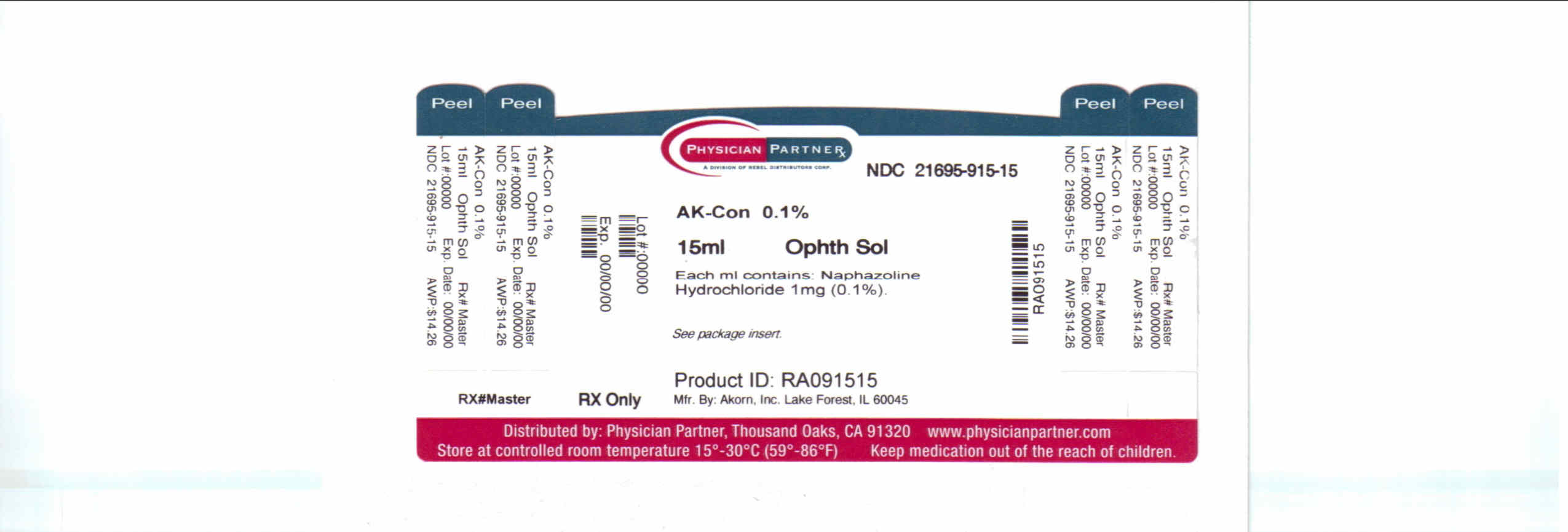Label: AK-CON- naphazoline hydrochloride solution
-
Contains inactivated NDC Code(s)
NDC Code(s): 21695-915-15 - Packager: Rebel Distributors Corp.
- This is a repackaged label.
- Source NDC Code(s): 17478-216
- Category: HUMAN PRESCRIPTION DRUG LABEL
- DEA Schedule: None
- Marketing Status: Abbreviated New Drug Application
Drug Label Information
Updated March 30, 2011
If you are a consumer or patient please visit this version.
- Download DRUG LABEL INFO: PDF XML
- Official Label (Printer Friendly)
- SPL UNCLASSIFIED SECTION
-
DESCRIPTION
Naphazoline hydrochloride, an ocular vasoconstrictor, is an imidazoline derivative sympathomimetic amine. It occurs as a white, odorless crystalline powder having a bitter taste and is freely soluble in water and in alcohol. The active ingredient is represented by the structural formula:

-
CLINICAL PHARMACOLOGY
Naphazoline constricts the vascular system of the conjunctiva. It is presumed that this effect is due to direct stimulation of the drug upon the alpha-adrenergic receptors in the arterioles of the conjunctiva, resulting in decreased conjunctival congestion. Naphazoline belongs to the imidazoline class of sympathomimetics.
- INDICATIONS AND USAGE
- CONTRAINDICATIONS
- WARNINGS
-
PRECAUTIONS
General:
For topical ophthalmic use only. Use with caution in the presence of hypertension, cardiovascular abnormalities, hyperglycemia (diabetes), hyperthyroidism, infection or injury.
Patient Information:
Patients should be advised to discontinue the drug and consult a physician if relief is not obtained within 48 hours of therapy, if irritation, blurring or redness persists or increases, or if symptoms of systemic absorption occur, i.e., dizziness, headache, nausea, decrease in body temperature, or drowsiness.
To prevent contaminating the dropper tip and solution, do not touch the eyelids or the surrounding area with the dropper tip of the bottle. If solution changes color or becomes cloudy, do not use.
Drug Interactions:
Concurrent use of maprotiline or tricyclic antidepressants and naphazoline may potentiate the pressor effect of naphazoline. Patients under therapy with MAO inhibitors may experience a severe hypertensive crisis if given a sympathomimetic drug. (See WARNINGS.)
Pregnancy:
Pregnancy Category C: Animal reproduction studies have not been
conducted with naphazoline. It is also not known whether naphazoline can cause fetal harm when administered to a pregnant woman or can affect reproduction capacity. Naphazoline should be given to a pregnant woman only if clearly needed.Nursing Mothers:
It is not known whether naphazoline is excreted in human milk. Because many drugs are excreted in human milk, caution should be exercised when naphazoline is administered to a nursing woman.
Pediatric Use:
Safety and effectiveness in pediatric patients have not been established. See “WARNINGS.” and “CONTRAINDICATIONS.”
- ADVERSE REACTIONS
- DOSAGE AND ADMINISTRATION
-
HOW SUPPLIED
Naphazoline Hydrochloride Ophthalmic Solution, USP) is supplied as a sterile 0.1% solution in
15 mL plastic dropper bottles. NDC 17478-216-12
Storage: Store at 20° to 25°C (68° to 77°F). Keep container tightly closed.
Rx Only
Manufactured by:
Akorn Inc.
Lake Forest, IL 60045Repackaged by:
Rebel Distributors Corp
Thousand Oaks, CA 91320
- Principal Display Panel
-
INGREDIENTS AND APPEARANCE
AK-CON
naphazoline hydrochloride solutionProduct Information Product Type HUMAN PRESCRIPTION DRUG Item Code (Source) NDC:21695-915(NDC:17478-216) Route of Administration OPHTHALMIC Active Ingredient/Active Moiety Ingredient Name Basis of Strength Strength naphazoline hydrochloride (UNII: MZ1131787D) (naphazoline - UNII:H231GF11BV) naphazoline hydrochloride 1 mg in 1 mL Inactive Ingredients Ingredient Name Strength edetate disodium (UNII: 7FLD91C86K) water (UNII: 059QF0KO0R) sodium chloride (UNII: 451W47IQ8X) SODIUM CARBONATE (UNII: 45P3261C7T) BENZALKONIUM CHLORIDE (UNII: F5UM2KM3W7) HYDROCHLORIC ACID (UNII: QTT17582CB) BORIC ACID (UNII: R57ZHV85D4) Packaging # Item Code Package Description Marketing Start Date Marketing End Date 1 NDC:21695-915-15 15 mL in 1 BOTTLE, PLASTIC Marketing Information Marketing Category Application Number or Monograph Citation Marketing Start Date Marketing End Date ANDA ANDA083590 08/22/1974 Labeler - Rebel Distributors Corp. (118802834) Establishment Name Address ID/FEI Business Operations Rebel Distributors Corp. 118802834 RELABEL, REPACK


